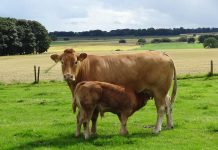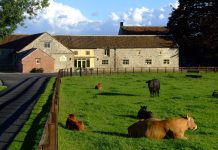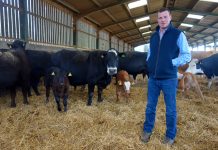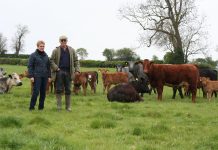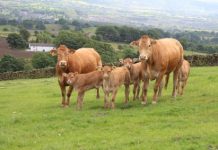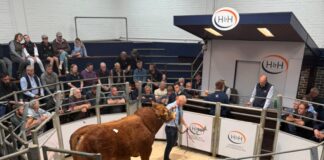Courtesy of The Scottish Farmer
Words: Kayley Kennedy
Photographs: Jacqueline Pettigrew
EVER SINCE its humble beginnings some 20 years ago, the Maybe herd of Limousin cattle has gone from strength-to-strength and has achieved some outstanding results, despite not focusing on selling bulls through the pedigree ring.
David and Rosemarie Cornthwaite relocated from the edge of the Lake District in Cumbria to their tenanted farm near Lockerbie nearly 23 years ago. Here, they took on the task of developing their commercial suckler herd and, in doing so, established a pedigree herd of Limousins.
“We arrived at Balgray Hill in March, 1991,” explained David. “At the time, the farm ran a mix of Blue-grey and Simmental cross Blue-grey cows which were put to Simmental and Charolais bulls. But, we were keen to switch to the Limousin to improve the growth rates and calving ease of the herd.”
Eager to start breeding their own bulls backed by proven family growth and femininity, David and Rosemarie founded the Maybe herd in 1994 with heifers from Hartside, Rufland and Sarkley herds, a cow from the Lodge herd and a privately purchased Ronick heifer. These, along with a cow bought from the College dispersal, created the base for the 40-strong herd and all members still trace to those initial six.
Running alongside them on the 2270 acres of Balgray Hill are 365 Limousin cross commercial cows, 15 Galloway females – under the Balgray prefix – and 1900 ewes, mostly Texel crossed with hill breeds. They also run a 30-strong pure Texel flock for breeding stock tups.
Helping David and Rosemarie are three full time stock men – Tom McGregor, Jason McKinnel and Tommy Rogerson – who, along with the Cornthwaites, have enjoyed turning out numerous show champions.
The best-known of these is Maybe Cute, a rising seven-year Ronick Hawk daughter out of Maybe Lovely. This 2013 Scottish Female of the Year was also the 2009 North West Limousin Cattle Breeders Association heifer derby winner and has many red, white and blue tickets under her belt. She lifted the inter-breed title at the 2012 Dumfries Show and, in 2013, was awarded the reserve inter-breed rosette at Kelso.
Her daughters are enjoying the sparkle of the show ring too, as her 2013-born heifer, Maybe Innocent, an AI-bred Frewstone Breakdance daughter, was breed and inter-breed champion at Langholm Show, in 2013, at only five months old. Further still, her sister – the Galbally C458-sired Maybe – won the same titles and trophies only the year before.
Maybe Girly was offered for sale at the Carlisle February 2014 Female sale where she secured the top price of 9,000gns.
“We’ve tried putting Cute to different bloodlines to the rest of the herd so that we can hopefully retain a stock bull in the future for the pedigrees,” Mr Cornthwaite commented of the herd favourite which they plan to flush to Breakdance in the coming months.
“Initially we did a lot of AI work before buying Hudscales Omar as a yearling at Carlisle. He really put some shape in to the calves as well as Marquis, a bull bought a few years later,” explained David.
Then, in March, 2007 they bought the Nenuphar-sired Bremore Artist, in a two-way split with Stephen Illingworth, of the Glenrock herd, when he stood Junior Champion at Roscrea.
“He then went on to stand Reserve Junior Bull Champion at the Royal Highland Show in the same year. He’s breeding big, growthy cattle with plenty of shape and natural fleshing that are good and quiet,” he added.
The following year the Cornthwaites forked out €8,000 for the aforementioned Galbally C458 – a Neuf son – again at Roscrea.
“The C458 bull is producing offspring which is very easily calved. The majority of heifers offered for sale next month are by him and in calf to Netherhall Epic, another easy calving bull,” David said, adding that Epic is a previous 12,000gns Carlisle sale bought privately a year later from Irish company, Progressive Genetics.
“Epic is a Sympa son and sits in ninth position in the breed for beef value at +49. His calves slip out easily and, despite being small at birth, quickly develop great width.”
Developing the herd has taken time but their efforts are certainly paying off as the Maybe herd has won its section of the North West club’s herd competition in 2009, 2010, 2011 and 2013 as well as taking second place in 2012.
Because of the large number of cattle at Balgray Hill, a new bull is bought every other year and covers the pedigree cows before going out to run with their commercial herd.
“This way we can determine how they’ll breed, and whether they’re more suited to the commercial or pedigree herds. Often we’ve bought a bull with the commercial herd in mind but if he produces some exceptional offspring we may well use him on suitable pedigree cows. The majority of the stock sires used on the commercial herd are home-bred,” he explained.
But it’s not only the pedigree stock that earns its keep as the commercial herd also pays its way. Each year, around 125 store calves (mostly bullocks) are sold at nine to 11 months of age at the March Continental sale at Carlisle where, last year, they levelled at £1140.
Following that, a batch of 65 is sold at the September Continental sale at 10-14 months where they averaged £1226. The female calves are either retained in the herd or finished and sold through Dumfries from late October through to July and, just last week, a group of four sold up to 243.5p per kg at a weight of 550kg.
“We initially finished all the calves at Balgray but switched to selling a bulk batch in March to free up some shed space for both calving and lambing. Plus, the store trade was good last year and the costs for finishing an animal had increased so we felt it made sense to follow the market,” he added.
But despite not selling at Stirling or Carlisle Bull Sales for a number of years, David and Rosemarie still regularly attend.
“Bull sales are important for us as it helps us keep abreast of trends within the breed and is a good indicator as to which blood lines are performing – and what consumers want in a bull,” he said. “Plus, we are always on the lookout for bulls which may enhance either our pedigree or commercial enterprises.”
And, ultimately, David feels that as long as the Limousin breed keeps its easy calving traits – which is becoming more important as there is less manpower on farms – and retains its natural fleshing ability, then the breed has a great future ahead.










